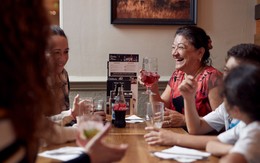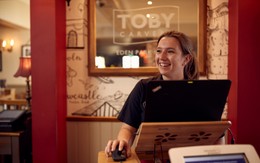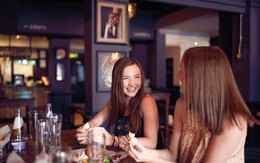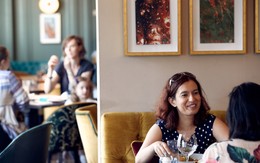(For the 52 weeks ended 24 September 2011)
Retained Estatea highlights
The Retained Estate represents the continuing operations of the Group following the major disposals completed over the last eighteen months and before exceptional items and other adjustments.
| FY 2011 £m | FY 2010 £m | % growth | |
| Revenuea | 1,762 | 1,680 | 4.9 |
| EBITDAa | 398 | 391 | 1.8 |
| Operating profita | 288 | 285 | 1.1 |
- Total sales up 4.9% including food sales up 7.8%
- Operating profit up 1.1% and operating margin at 16.3%
- EBITDA returns of 21% achieved on expansionary capex invested over the last two years
- Net debt reduced by over £400m; net debt:EBITDA now at 4.7 times
- Like-for-like sales in FY 2011 of +2.6% with food like-for-like sales of +4.8%
- Like-for-like sales growth of 2.0% in first 8 weeks of FY 2012
Bob Ivell, Executive Chairman, commented:
"This is a resilient set of results despite a challenging year with a difficult consumer environment, board changes and a takeover approach. Mitchells & Butlers is a good business and our ambition is to make it a great business. We have a number of initiatives in place to do this including the simplification of our central support functions to enhance business performance. Overall, this gives us confidence in successfully growing the business in the year ahead."
Total Group performance
Total Group results include the impact from the major disposals of pubs, bowls and lodges.
| FY 2011 £m | FY 2010 £m | % growth | |
| Revenue | 1,796 | 1,980 | (9.3) |
| Adjusted operating profitb | 294 | 322 | (8.7) |
| Adjusted profit before taxb | 156 | 169 | (7.7) |
| Profit before tax | 132 | (127) | - |
| Adjusted earnings per sharec | 28.0p | 29.7p | (5.7) |
| Basic earnings per share | 30.7p | (20.6p) | - |
Notes
a - The Retained Estate comprises the ongoing business and is stated before exceptional items and other adjustments. It excludes the major disposals of 333 non-core pubs, lodges and Hollywood Bowl, and in addition SCPD (a property company holding a small, residual land bank). This is shown in note 2
b - Adjusted operating profit and adjusted profit before tax are stated before exceptional items and other adjustments as set out in note 3
c - Adjusted earnings per share is profit after tax before exceptional items and other adjustments, divided by the weighted average number of ordinary shares in issue
There will be a presentation for analysts and investors at 8.30am at Nomura International plc, 1 Angel Lane, London, EC4R 3AB. A live webcast of the presentation will be available at www.mbplc.com. The conference will also be accessible by phone by dialling +44 207 153 8942, quote "Mitchells & Butlers", the replay will be available until 06/12/11 on +44 121 260 4861 replay access pin 5448126#.
All disclosed documents relating to these results are available on the Group's website at www.mbplc.com
For further information, please contact:
| Tim Jones - Finance Director | +44 (0)121 498 5612 |
| Erik Castenskiold - Director of Corporate Affairs | +44 (0)121 498 6513 |
| James Murgatroyd (Finsbury Group) | +44 (0)207 251 3801 |
Notes for editors:
- Mitchells & Butlers' leading portfolio of brands and formats includes Harvester, Toby Carvery, Vintage Inns, Premium Country Dining Group, Crown Carveries, Sizzling Pubs, Browns, Miller & Carter, Metro Professionals, All Bar One, Nicholson's, O'Neill's and Ember Inns. Further details are available at www.mbplc.com and supporting photography can be downloaded at www.mbplc.com/imagelibrary.
- Mitchells & Butlers serves around 125 million meals and 425 million drinks each year and is one of the largest operators within the UK's £70 billion eating and drinking out market.
- Like-for-like sales growth includes the sales performance against the comparable period in the prior year of all UK managed pubs that were trading in the two periods being compared. For the 52 weeks to 24 September 2011, 94% of the estate is included in this measure.
EXECUTIVE CHAIRMAN'S REVIEW
Mitchells & Butlers is the UK's largest operator of restaurants and pubs, with a leading portfolio of well-recognised brands and a high quality freehold estate. Food is our largest selling product having grown by 30% over the last four years and this has helped generate a 16% rise in profits per site over the same period. As a result, the estate has high average weekly sales and annual profitability per site, at over £22k and £180k respectively, both well above the average of our major competitors.
This year has seen good progress towards achieving our strategic objectives despite a challenging consumer and inflationary cost environment. We continue to actively develop and implement a number of sales and cost initiatives that will help further enhance our competitive position.
Sales growth
The Retained Estate delivered 4.9% sales growth in the year with total food sales growth of 7.8% and drinks sales up 2.3%.
On a like-for-like basis, sales growth in the financial year was 2.6% with food like-for-like sales up 4.8% and drink up 1.0%.
| Like-for-like sales growth | FY 2010 Week 1-52 | FY 2011 Week 1-52 | FY 2012 Week 1-8 |
| Total | 2.8% | 2.6% | 2.0% |
| Food | 4.7% | 4.8% | 1.8% |
| Drink | 1.4% | 1.0% | 3.0% |
Over the first eight weeks of the new financial year our like-for-like sales grew by 2.0% which reflects the impact of strong early sales, driven by good weather, on an underlying current run rate of around 1%.
Operating profit
The Retained Estate operating profit increased in the year by 1.1% driven by higher sales and increasing pub numbers.
Operating margin was down 0.7 percentage points to 16.3% due to a number of inflationary and regulatory pressures. These industry-wide cost rises relate to increases in food, energy, alcohol duty, National Minimum Wage, business rates and the introduction of the Carbon Reduction Commitment. Efficiencies in areas such as purchasing and wastage reduction mitigated some of the impact of these cost pressures.
Brand roll-out
There continue to be good freehold and leasehold investment opportunities to develop new sites across our brand portfolio. As a result 53 new sites were opened in the year, slightly ahead of our target of 50 new openings. These include 21 of the 22 Ha Ha Bar & Grill sites acquired in November 2010, 16 new sites on leisure and retail parks and 16 other, mainly freehold sites. During the year we also converted 48 of our existing sites to our expansion brands.
EBITDA returns on expansionary capital have improved from 19% as at the half year to 21%, with our new openings programme performing especially well. Within this, our investments in leasehold retail and leisure park sites have delivered particularly strong returns of over 30% and we see a good pipeline of opportunities to expand further in this area, alongside our continued investments in new freehold sites.
Business initiatives
The Group is actively implementing a number of business initiatives to underpin future profitability and increase long term shareholder value. These include a reorganisation of the Group's IT infrastructure and an initiative to simplify the central support functions.
Central support processes will be improved by devolving greater responsibility and accountability to customer facing operations, in order to enhance the guest experience and continue to grow the business. The first stage of this programme is the appointment of Robin Young as Operations Director with accountable brand groups reporting directly into him, each led by a Brand Operations Director. Robin was previously Commercial Director and has significant operational and change management experience across a variety of companies. Further changes in operational and central support structures are anticipated and as a result, a consultation period is being initiated within the Group.
Outlook
The consumer environment remains challenging. We expect inflationary cost pressures to persist in the new financial year, especially from energy, duty and food. We will seek to mitigate the impact of these cost increases with the effective implementation of our business initiatives and will continue to take advantage of attractive capital investment opportunities. Overall, Mitchells & Butlers' strong portfolio of assets, brands and operational skills means that it is well positioned to grow further in the year ahead.
FINANCIAL REVIEW
Retained Estate results
Total revenues were up 4.9% to £1,762m, with food sales up 7.8% and drink sales up 2.3%. Food sales are now our largest income line, representing just over 48% of total sales and remain a key driver of total sales growth. We estimate that nearly three quarters of our sales relate to guests using our businesses to eat.
Despite an increasingly challenging consumer environment, across the full year, like-for-like sales growth was 2.6%. Food like-for-like sales were up 4.8% mainly driven by increasing food spend per head with the number of meals sold, slightly lower. Drink like-for-like sales were up 1.0% with volumes down, partly on the back of increasing duty costs that have led to higher average drink prices.
There were a number of inflationary cost increases during the year which were partially offset by efficiencies in purchasing and waste reduction. Outlet employment costs as a percentage of sales increased marginally by 0.1 percentage points to 24.8%.
Retained Estate EBITDA grew 1.8% to £398m and EBIT grew 1.1% to £288m. As a result of the cost pressures described above, operating margins were 16.3%.
Total Group results
Other operations including the 333 non-core pubs, Hollywood Bowl and lodges contributed £34m of revenue and £6m of operating profit in the year, against £300m of revenue and £37m of operating profit in the prior year (FY 2010). As a result, total Group revenues were down 9.3% to £1,796m and operating profit before exceptional items were down 8.7% to £294m.
Net interest costs were £138m, £15m lower than last year as a result of lower net debt and the repayment and cancellation of the unsecured medium term and revolving credit facility. Profit before tax and exceptional items was £156m, 7.7% lower than last year.
The pre-exceptional tax charge of £42m is an effective rate of 27% of profit before tax representing a small decrease from the previous year due mainly to the reduction in the UK standard rate of corporation tax.
Earnings per share before exceptional items were 28.0p, down 1.7p against last year. Statutory basic earnings per share after exceptional items were 30.7p. This compares to a 20.6p loss last year primarily due to an exceptional property revaluation charge in that year of £304m.
Internal rent
The system of internal rents implemented at the start of the year is now fully in place and aligns our internal performance measurement across leasehold and freehold sites.
| Retained Estate | Operating £m | Property £m | Total £m |
| Turnover | 1,762 | 1,762 | |
| EBITDAR | 439 | 439 | |
| External Rent | (41) | (41) | |
| Internal Rent | (190) | 190 | - |
| EBITDA | 208 | 190 | 398 |
| EBITDA % | 11.8% | 22.6% |
Exceptional items and other adjustments
Total exceptional items and other adjustments decreased profits before tax by £24m and consisted of a charge of £13m relating to the curtailment of the defined benefit pension scheme as at March 2011 (see further below); a £5m net pensions finance charge; a £4m loss on the disposal of properties; and a £2m charge relating to the valuation of the property portfolio and impairment review. An exceptional deferred tax credit of £35m has been recognised which principally represents the tax impact of the above items including a release of deferred tax relating to asset disposals, as well as the impact of the reduction in the UK standard rate of corporation tax.
Dividends
The Board continues to monitor operating cash flow generation and capital investment opportunities before taking a decision on the timing and quantum of the resumption of dividend payments.
Capital expenditure and disposals
Total capital expenditure in the year was £172m, a significant increase from £138m spent in FY 2010. £82m was invested in expansionary capital and £82m was spent maintaining and enhancing the high level of amenity in our pubs. A further £8m was spent on infrastructure projects including upgrades to our till systems, updates to the stock & labour scheduling systems and improvements to the energy efficiency of our restaurants and pubs.
In total the business raised £424m through disposals in the year.
Cash flow and balance sheet
A Red Book valuation of our freehold and long leasehold estate has been completed in conjunction with our property valuers in addition to an impairment review on the short leasehold and unlicensed assets. The overall increase of £71m represents a 2% increase in the estate valuation and is reflected as a £2m charge to the income statement and a £73m increase in reserves. We continue to moderate the value of our larger, high profitability sites as there are few comparable industry multiples for these high performing sites.
Cash flow from operations of £336m was generated by £404m of EBITDA, increased by £5m of non-cash items and reduced by £40m of additional contributions to the pension schemes and £33m due to working capital movements, principally relating to the disposed businesses. After payments for net interest of £134m, tax of £20m, maintenance capital expenditure of £90m and share capital inflows of £2m, free cash flow of £94m was generated in the year. After expansionary capital expenditure and proceeds from disposals, net cash flow in the year was £436m.
As a result, net debt reduced to £1,870m in the year, consisting of net debt within the securitisation of £2,089m and net cash held outside the securitisation of £219m. Total group net debt is a multiple of 4.7 times Retained Estate EBITDA, down from 5.1 times at the last year end.
Pensions
As reported last year, the defined benefit section of the pension plan ceased future accrual for active employees as at 13 March 2011. Employees were offered a transfer to the defined contribution section of the plan at this date. This transition led to an exceptional charge being recognised during the year of £13m due to the projected RPI increases for deferred pensions being higher than the 2% capped salary increases assumption for active members.
Following the closure of the defined benefit scheme on 12 March, the Company reviewed the appropriate accounting under IFRIC 14 for the Company's funding obligations and as a result of this review has restated the accounting at 25 September 2010, reducing both the pension liability and the related deferred tax asset.
The pre-tax pension deficit as at 24 September 2011 reduced to £37m (FY 2010: deficit of £143m). This reduction is due to an increase in corporate bond yields, which are used to discount scheme liabilities; an increase in the value of the scheme's assets mainly driven by higher government bond prices as yields fell; and additional Group contributions of £40m during the year.
53 weeks in FY 2012
The next financial year will be for the 53 weeks ending 29 September 2012.
Directors' statement on the annual report
The responsibility statement below has been prepared in connection with the Group's full Annual Report for the 52 weeks ended 24 September 2011. Certain parts thereof are not included within this announcement.
Responsibility statement
We confirm to the best of our knowledge:
- The financial statements, prepared in accordance with IFRSs as adopted by the European Union, give a true and fair view of the assets, liabilities, financial position and profit or loss of the Group and the undertakings included in the consolidation taken as a whole; and
- The Executive Chairman's Review, Financial Review and Risks and Uncertainties sections, which are incorporated into the directors' report, include a fair review of the development and performance of the business and the position of the company and the undertakings included in the consolidation taken as a whole together with a description of the principal risks and uncertainties they face.
This responsibility statement was approved by the Board of Directors on 21 November 2011 and is signed on its behalf by Bob Ivell, Executive Chairman and Tim Jones, Finance Director.





